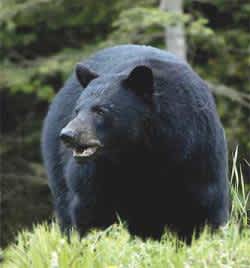Pennsylvania’s 5-Day Archery Bear Season Starts Nov. 12
OutdoorHub 11.09.12

Pennsylvania Game Commission officials said bear hunters soon will be able to enjoy a four-day statewide bear season, in addition to a full-week archery bear season and a series of extended bear seasons in certain Wildlife Management Units (WMUs) during the upcoming fall months.
The statewide archery bear season, which will be held Nov. 12-16, will lead up to the four-day statewide bear season, which will open on Saturday, Nov. 17, and then run from Monday through Wednesday, Nov. 19-21. The extended bear seasons will be held in certain WMUs and portions of WMUs the following week during deer season.
In WMUs 2B, 5B, 5C and 5D, an extended bear season will run concurrently with the entire two-week deer season, Nov. 26-Dec. 8. This extended season is in addition to overlapping bear and deer hunting opportunities held in these four WMUs during the archery deer and early muzzleloader and firearms deer seasons. These seasons were approved by the Board of Game Commissioners as a means of achieving the agency’s goal of reducing bear-human conflicts in these urbanized areas of southwestern and southeastern corners of the state.
In WMUs 3D, 4C, 4D, 4E, an extended bear season is open Nov. 28-Dec. 1. An extended bear season also will be held Nov. 26-Dec. 1 in the following:
- All of WMUs 3A and 3C;
- Portions of WMU 3B, that are East of Rt. 14 from Troy to Canton, East of Rt. 154 from Canton to Rt. 220 at Laporte and East of Rt. 42 from Laporte to Rt. 118, and that portion of WMU 4E, East of Rt. 42; and
- Portions of WMU 2G in Lycoming and Clinton counties and WMU 3B in Lycoming County that lie North of the West Branch of the Susquehanna River from the Rt. 405 Bridge, West to Rt. 15 at Williamsport, Rt. 15 to Rt. 220, and North of Rt. 220 to the Mill Hall exit, North of SR 2015 to Rt. 150; East of Rt. 150 to Lusk Run Rd. and South of Lusk Run Rd. to Rt. 120, Rt. 120 to Veterans Street Bridge to SR 1001; East of SR 1001 to Croak Hollow Rd., South of Croak Hollow Rd. to Rt. 664 (at Swissdale), South of Rt. 664 to Little Plum Rd. (the intersection of SR 1003), South of SR 1003 to SR 1006, South of SR 1006 to Sulphur Run Rd., South of Sulphur Run Rd. to Rt. 44, East of Rt. 44 to Rt. 973, South of Rt. 973 to Rt. 87, West of Rt. 87 to Rt. 864, South of Rt. 864 to Rt. 220 and West of Rt. 220 to Rt. 405 and West of Rt. 405 to the West Branch of the Susquehanna River.
“Pennsylvania’s bear population covers more than three-quarters of the state, and includes a number of world-class trophy bears,” said Carl G. Roe, Game Commission executive director. “This has earned Pennsylvania recognition as one of the top states for bear hunters. Every year, we have a number of bears exceeding 500 pounds included in the harvest.”
Since 1992, six bears with an estimated live weight of 800 pounds or more have been legally taken in Pennsylvania. The possibility of another 800-pounder being taken by a hunter is always in play when Pennsylvania’s bear season opens.
In 2011, hunters harvested 4,350 bears, which was the highest harvest in Pennsylvania history. In 2005, hunters took 4,164 bears, which was the second highest number. Over the past 10 years, hunters have taken more black bears than in any other decade since the Game Commission began keeping bear harvest records in 1915.
“Conditions this year are favorable for another record harvest,” said Mark Ternent, Game Commission bear biologist. “Bear populations are up in many parts of the state relative to past years, hunter participation is expected to be good, based on the number of bear licenses being purchased, and acorn crops are above average, which keeps bears out of hibernation longer and available to hunters. The only real unknown is if we will have favorable weather for hunting on opening day.”
Bears were taken in 54 counties last year, which was the same as 2008, 2009 and 2010, but an increase from 2007, when bears were taken in 49 counties.
The 2011 bear harvest by WMU for both the archery and four-day bear seasons, including 2010’s harvest results in parentheses, were: WMU 1A, 13 (11); WMU 1B, 64 (42); WMU 2A, 0 (1); WMU 2B, 1 (0); WMU 2C, 226 (307); WMU 2D, 150 (146); WMU 2E, 79 (94); WMU 2F, 345 (202); WMU 2G, 1,086 (894); WMU 3A, 564 (199); WMU 3B, 479 (234); WMU 3C, 299 (118); WMU 3D, 318 (284); WMU 4A, 72 (135); WMU 4B, 70 (55); WMU 4C, 148 (90); WMU 4D, 355 (245); WMU 4E, 79 (31); WMU 5A, 1 (0); and WMU 5C, 1 (2).
To participate in any bear season, hunters must have a general hunting license and a bear license, which they can purchase through Nov. 16, or Nov. 22-25. During the four-day bear season, which runs from Nov. 17-21, bear license sales will temporarily be closed. Bear licenses are not part of the junior or senior combination licenses, and must be purchased separately.
All hunters who harvest a bear must immediately tag it with their field harvest tag that is part of the bear license, and, if during the statewide four-day season or the extended seasons, transport the carcass – minus entrails – to one of the Game Commission bear check stations within 24 hours, and present it for checking along with their general hunting license and bear license. During the archery season, hunters must tag the bear in the field and then contact a Game Commission region office within 24 hours to have their bear checked.

